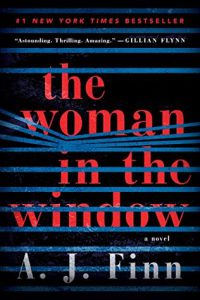Search the Blog
Categories
- Books & Reading
- Broadband Buzz
- Census
- Education & Training
- Friday Reads
- General
- Grants
- Information Resources
- Library Management
- Nebraska Center for the Book
- Nebraska Libraries on the Web
- Nebraska Memories
- Now hiring @ your library
- Preservation
- Pretty Sweet Tech
- Programming
- Public Library Boards of Trustees
- Public Relations
- Talking Book & Braille Service (TBBS)
- Technology
- Uncategorized
- What's Up Doc / Govdocs
- Youth Services
Archives
Subscribe
Tag Archives: Friday Reads
Friday Reads: What Elephants Know by Eric Dinerstein
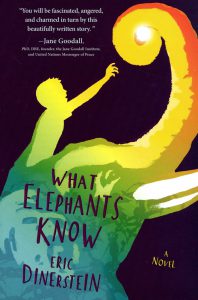 Set in the 1970s, Nandu (12) was found alone at about age 2, except for a pack of wild dogs protecting him, in the Nepalese Borderlands, having been abandoned by his parents. He was unofficially adopted by the Subba-sahib, the head of an elephant stable in the Borderlands, a very southern part of Nepal. The King of Nepal owns the stable and the elephants, but only rides once a year to hunt tigers in the area. Nandu is learning to handle elephants and become a mahout (an elephant trainer) – his charge is an older female elephant called Devi Kali, and she is protective of him.
Set in the 1970s, Nandu (12) was found alone at about age 2, except for a pack of wild dogs protecting him, in the Nepalese Borderlands, having been abandoned by his parents. He was unofficially adopted by the Subba-sahib, the head of an elephant stable in the Borderlands, a very southern part of Nepal. The King of Nepal owns the stable and the elephants, but only rides once a year to hunt tigers in the area. Nandu is learning to handle elephants and become a mahout (an elephant trainer) – his charge is an older female elephant called Devi Kali, and she is protective of him.
The beauty and danger of nature is explored and appreciated, as Nandu, Devi Kali, and other mahouts and elephants walk to the river for the elephants’ baths and sometimes must go into the jungle. Orphan rhino calves are rescued by the boys and tended by Rita, the sister of Nandu’s friend, Dilly. And sometimes the wild dogs provide unexpected assistance.
When Nandu is sent away to school, hopefully to learn things that will help the stable, he finds bullies and a couple of friends. One teacher accepts his invitation to visit the stable, and Father Autry’s wisdom is very helpful to Nandu and the Subba-sahib. The stable is threatened with closure, and at first the Subba-sahib takes no action, only waiting for the King’s reply to his request not to close. Things are beginning to look dire when Rita suggests they change their focus to becoming a breeding stable. It becomes Nandu’s job to travel to the elephant sale and buy a tusker worthy of their elephants, an event he has never attended and something he knows little about. Will he be successful and will that keep the stable alive?
Books that contain a great story and some actual facts about animals have always appealed to me. This title will appeal to middle grade readers (grades 4-7) who are likewise interested in animal stories. I have not yet read the companion novel (listed below), but I am going to have to find myself a copy.
Awards include winning the 2017 South Asia Book Award for Children’s and Young Adult Literature, and being named a 2017 ALA Notable Children’s Book.
What Elephants Know is followed by A Circle of Elephants: A Companion Novel, which was published in January of 2019.
Dinerstein, Eric. What Elephants Know. Disney-Hyperion, 2016.
Friday Reads: The Last Policeman
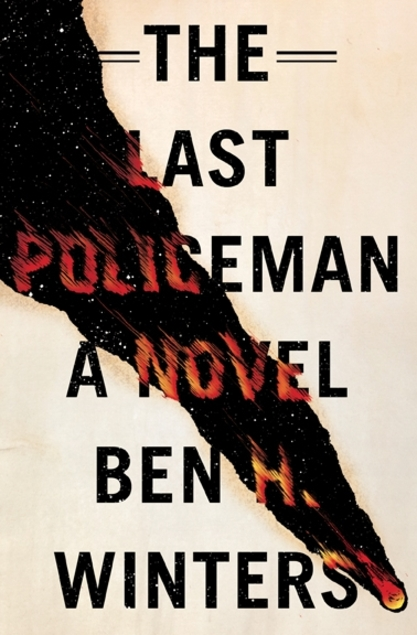 In six months’ time, an asteroid is going to slam into the Earth, ending all life as everyone knows it, and Detective Hank Palace just wants to do his job.
In six months’ time, an asteroid is going to slam into the Earth, ending all life as everyone knows it, and Detective Hank Palace just wants to do his job.
Peter Zell – actuary, ordinary, quiet man, fellow-waiter-for-the-End – is found dead in a McDonald’s bathroom. Suicide, of course. It must be, because all over Concord, and all over the world, people are killing themselves in a preemptive epidemic – it’s the end of the world, and things are beginning to get bad, and they’re only going to get worse before – BAM! – so why not get it out of the way sooner rather than later?
Only Hank – who wanted to be a detective since he was a kid, now, finally, has the chance; all around him people are walking off their jobs, because who wants to clock in when death, confirmed in odds and orbit is hurtling on a direct and unstoppable path towards your species’ sole habitable planet? And those people happen to include detectives, which means rookie cops get promoted years early, making Hank the luckiest, unluckiest man in Concord, depending on your perspective; hey kid, you made it, sorry about the asteroid. Ain’t the just the old sting of existential dread that comes with being a Millennial? – Only Hank isn’t so sure Peter Zell killed himself. Hank, still mostly bright-eyed, still dedicated, with Farley and Leonard’s Criminal Investigation’s textbook memorized, is pretty sure that Peter Zell was murdered.
The Last Policeman is not your everyday detective novel. The elements of a typical mystery are there: the suspects, the clues, the red herrings and the twists, the suspense that moves quick enough to have your spine straightening and your eyes brightening with quickened interest; did we get ‘em, did we figure it out? Remove the asteroid and you have a standard detective story: was a man murdered, and for what? Depending on who the man was, maybe there’s less dragging of feet. Put back the asteroid. Now a man is dead. Maybe murdered, maybe not; does it matter?
To Hank, it matters. He wants to know the story (175). He wants to do his job; a man is dead and that matters, even though they’re all going to die.
I love a good detective story, and if there’s a good, solid human element mixed with a literary style, then I am sold. Winters crafted a doomed world but kept Hank’s chin up enough despite, as one character calls it, “the weight of all this unbearable immanence” (39). It’s a complicated, bittersweet novel that surprised me by having bright moments of humor. Since it is the first in its trilogy, it left some threads dangling, and I am curious to see how Winters develops those plotlines. It is interesting to start a series where the end is pretty much a given – and not a particularly, one must assume, happy end. There was an element of denial I found myself falling into as I read. Because I – like Hank, like everyone – don’t want it to end like that.
Which creates a fascinating connection between the characters and the reader: to hope, in that ever-irrational, ever-human way, for an impossible way out; that somehow, someone failed to carry a one somewhere and threw the entire model off course; that at the last moment the asteroid is going to veer away and the disaster will be averted and we will all go on living.
The Last Policeman is followed by Countdown City and World of Trouble.
Winters, Ben H. The Last Policeman. Quirk Books, 2012.
Friday Reads: We Have Always Lived in the Castle
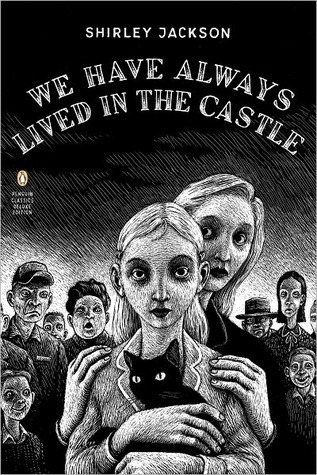 “Merricat, said Connie, would you like a cup of tea?
“Merricat, said Connie, would you like a cup of tea?
Oh no, said Merricat, you’ll poison me.
Merricat, said Connie, would you like to go to sleep?
Down in the boneyard ten feet deep!”
I recently finished Shirley Jackson’s 1962 work “We Have Always Lived in the Castle.” There’s definitely something lyrical in Jackson’s writing, that perfectly mirrors the narrator, Mary Katherine or “Merricat’s,” sing-song thought process. The children’s rhyme above is repeated throughout the novel underlining the story’s natural rhythm. Merricat lives an isolated existence with her older sister Constance and their invalid Uncle Julien. While Merricat is in her late teens, she still has a childlike existence, playing in the woods, burying treasure, her sole companion (outside her family) a cat named Jonas. Through her, we learn the backstory of a dark family tragedy, the death of her parents, brother, and aunt by poison six years earlier. The authorities charged Constance with murder and she’s acquitted of the crime but it leaves her agoraphobic, unwilling to leave the family’s large estate. The sisters are taunted and ostracized by the small local village, by the children and adults alike. And just as you are settling into this family’s strange routine, a long-lost family member shows up on their doorstep and turns their little world on its head.
I chose this book for a couple of reasons, first, I’m trying to get out of my comfort zone and read different genres and authors. I thought I’d dip my toe in horror with this book and move on to Jackson’s “The Haunting of Hill House” next if it all went well. My second reason is that the movie recently hit theatres and it’s always my goal to read the book first. This was my first Shirley Jackson book, and it will not be my last.
Jackson, Shirley. We Have Always Lived in the Castle. Penguin Classics, 2006.
Friday Reads: Sissy: A Coming-of-Gender Story by Jacob Tobia
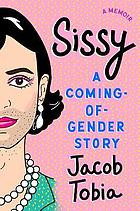 Sissy: A Coming of Gender Story is a comic memoir by Jacob Tobia. I recommend the audiobook, read by the author, whose voice is a like a comfortable but sparkly sweater. Tobia is a vegetarian, gender-nonconforming, Syrian-American from North Carolina who got into (but didn’t go to) Harvard, and who grew up loving Sunday School; and if you don’t already know that you have a lot in common with our author, you will realize it quickly.
Sissy: A Coming of Gender Story is a comic memoir by Jacob Tobia. I recommend the audiobook, read by the author, whose voice is a like a comfortable but sparkly sweater. Tobia is a vegetarian, gender-nonconforming, Syrian-American from North Carolina who got into (but didn’t go to) Harvard, and who grew up loving Sunday School; and if you don’t already know that you have a lot in common with our author, you will realize it quickly.
Tobia tells their story in an irreverent and authentic way, focusing on recognizing human needs, understanding human impulses, acknowledging human discomfort and pain, and just simply being a living and learning person. You might expect the book to be sad or “heavy,” and Tobia does not shy away from frank discussion and language about serious and emotional topics and events. But the book is funny, even while addressing all of that with respect (and did I mention frank language?). As Tobia told Salon in an interview about the book, “I don’t want to talk about what being trans means so much as I want to talk about how being trans feels.” Tobia is not trying to tell the one trans narrative that speaks for all trans people—they are telling one person’s story, their own, and we can all relate.
In the introduction, Tobia discusses gender identity in the context of physical and emotional health that’s especially illuminating. We all have a relationship with our bodies and our genders, relationships that are dynamic over our lifetimes. And we don’t stop growing and learning when we become adults. If anything, that’s when the truly informed growth and awareness can start. The book goes on to tell an engaging story that is far from being over.
Tobia, Jacob. Sissy : A Coming-of-Gender Story. Penguin Publishing Group, 2019.
Friday Reads: The Lost for Words Bookshop
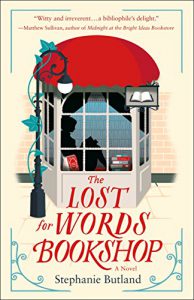 The Lost for Words Bookshop by Stephanie Butland opens with Loveday Cardew, rescuing a book from the gutter in York. England, not Nebraska. Just thought I would clarify so you can get the accent right in your mind. Anyway, the book she pulled from the gutter is sheer poetry, mixed with a bit of mud and grit. It also leads her to another poet, but that’s all I’ll say about that.
The Lost for Words Bookshop by Stephanie Butland opens with Loveday Cardew, rescuing a book from the gutter in York. England, not Nebraska. Just thought I would clarify so you can get the accent right in your mind. Anyway, the book she pulled from the gutter is sheer poetry, mixed with a bit of mud and grit. It also leads her to another poet, but that’s all I’ll say about that.
Despite her name, Loveday hates people with an awkward passion. It’s easier to control written people than real. When characters annoy you, just skip a few pages or shut the book in their face. It’s been known to happen.
But there is a bit of love mixed between the pages of The Lost for Words Bookshop. Not surprisingly, Loveday is the Byronic hero(ine) with the tortured past here. There is always a tortured past, isn’t there? But it’s not all angst. If it were, I wouldn’t be writing this review right now. I would have shut the book in her face. With enthusiasm!
Instead there is growth and a tentative hope for a better future. As often happens, this book about books is really about people. Loveday’s journey shifts between Crime, Poetry, and History. These are not my favorite sections of the bookstore, but this is also not your traditional crime novel. This particular crime had been solved years ago. Sort of. The mystery was how to deal with the fallout. You’ll have to read it to find out.
If you like books about the love of books, paired with a heroine who is discovering life, The Lost for Words Bookshop will help you find your way.
Friday Reads: Just One Damned Thing After Another: v.1, The Chronicles of St. Mary, by Jodi Taylor
Just One Damned Thing After Another: Chronicle of St. Mary’s, by Jodi Taylor shows how historians are trained to “investigate major historical events in contemporary time.”, but don’t call it time travel! Actually, I started this series with what I thought was the last book, Lies, Damned Lies, and History, v.7 and was so intrigued with the characters that I wanted to start the series from the beginning!

Just One Damned Thing After Another by Jodi Taylor
It begins with Max, (Madeline Maxwell), a disruptive, unhappy, student, being mentored in school by her head teacher. Next, a letter from the same head teacher, guides her from academe to the doors of St. Mary’s Institute of Historical Research, an adjunct of the University of Thirsk. Taking the tour of the facility with her mentor, she notices some oddities: little remarks about not having had an interview, she notices they have a security section, and a hanger named after Stephen Hawking. Finally she has “the interview” with the facility, which is when the real reveal of what they do at St. Mary’s occurs. Since she studied archeology and anthropology, with emphasis in Greek and Roman times, and has experience in archeological digs, she jumps at the chance to time travel. She signs up, and joins a small class of would be “historians”.
It is set in the UK in the fairly near future. The relationship with the University is of course fraught with politics and academic tensions. The borders of America (The United Sates) have been closed. And a great deal of funding is going toward Mars exploration, or a possible manned Mars trip. And, as a side note, all of this is run by some members of the same institution, but from a future form of the same institution. And the muse of history is the director’s PA (personal assistant).
While it isn’t perfect, the series is fun, raucous, accident prone, and in turns, deadly serious and on a dull weekend, or too cold, or too hot Nebraska day, the perfect antidote to very nearly everything. If you grew up on James Bond, Benny Hill, Saturday Night Live, Dr. Who, Monty Python’s Flying Circus, or simply like any or all of those shows, this is just the thing for you! Especially if you don’t mind it filled with really interesting parts of History, that feel well researched.
Chronicles of St. Mary, in order, as best as I can tell:
- Just One Damn Thing After Another
- A Symphony of Echos
- A Second Chance
- A Trail Through Time
- No Time Like the Past
- What Could Possibly Go Wrong?
- Lies, Damned Lies, and History
- And the Rest is History
- An Argumentation of Historian
Various Short Stories–Please muddle through them as you will!
Just One Damned Thing After Another: Chronicle of St. Mary, book 1, by Jodi Taylor, Nightshade, 9781597808682, 2013, paper back, $12.99
#BookFaceFriday “Stoner”
This week’s #BookFaceFriday is kind of a bummer, man…
Does this #BookFace look familiar? You might recognize this cover from Sam Shaw’s recent Friday Reads post about “Stoner” by John Williams (NYRB Classics, 2006). Sam, our Planning and Data Coordinator, was gracious enough to pose for this week’s photo.
“A beautiful, sad, utterly convincing account of an entire life…I’m amazed a novel this good escaped general attention for so long.” —Ian McEwan
Friday Reads is a weekly book review series posted by Nebraska Library Commission staff. Former NLC staffer Laura Johnson created this series to model the idea of talking about books and to help readers get to know our staff a little better. We hope that our book reviews will start a conversation about books among our readers and encourage others to share their own reviews and recommendations. Past Friday Reads are archived on the NCompass blog, or you can browse a list of reviews here.
Love this #BookFace & reading? Check out our past #BookFaceFriday photos on the Nebraska Library Commission’s Facebook page!
Posted in Books & Reading
Tagged #FridayReads, Book Face Friday, bookface, bookfacefriday, Friday Reads
Leave a comment
Friday Reads: The Woman in the Window, a novel by A.J. Finn
Shortly after I started back in April I was asked if I wanted to contribute to the commissions “Friday Reads” blog and of course I said “Yes!” And then I froze. I had been moving so I haven’t read anything in a while! Nothing I had with me seemed to work and nothing recently seemed intriguing. So after some (okay…a lot!) of browsing I finally came across “The Woman in the Window” by A.J. Finn. It mainly caught my eye as my cover says “Soon to be a major motion picture” and I’m the type of person who always has to read the book first. Rarely is a movie better than the book but with this one we’ll just have to wait and see.
Told from the perspective of one Dr. Anna Fox who, due to her battle with agoraphobia, has spent the last ten months in her house having what she can delivered so she never has to leave. She keeps tabs on her neighborhood through the lens of her camera and “see’s something she shouldn’t”. I’ve never seen “Rear Window”, or much of it at least, but it seems like there are a number of connections that can be made between this book and the movie. A person trapped in their home thinks they see something nefarious and people don’t believe them. The connection is made even stronger through Anna’s own love of old movies, including “Rear Window”, which are referenced throughout the book.
As for the rest of the characters A.J. does a good job fleshing each of them out but I hate to say it – he does nothing with them. Most of them have very little connection to the plot and you never really get to know any of them well. Unfortunately, you never really get to know Anna very well either as major parts of her story, and why she is the way she is, aren’t revealed until you’re ¾ of the way through the book. Thankfully the book redeems itself in other ways and really is a quick read. The “chapters”, some of which are only a page long, are grouped together by date and the flow that this gives the book never waivers. Plus, the way AJ writes really gives you an almost visceral feel for what’s going on (hence the reason I feel that if done right the movie might out shine the book.)
I wouldn’t recommend “Woman in the Window” to hard core mystery buffs, but other than that I found the book enjoyable. I normally don’t like mysteries as I find it frustrating that I usually figure it all out only sentences before the characters do. “The Woman in the Window” is more suspense story than a true “who-done-it” type of mystery, though, and it keeps you on your toes by throwing twists and turns at you constantly making you, and Anna, question if your reasoning is correct. With that being said in the end I was able to figure out the “who” well before it’s revealed in the book.
Friday Reads: The Book of Tomorrow, A Novel by Cecelia Ahern
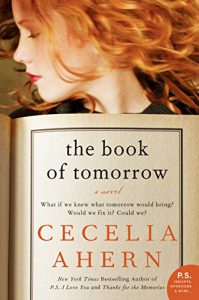 Once again, I have come across a book in the mystery sub-genre of Bibliomystery. In The Book of Tomorrow, Cecilia Ahern’s intriguing narrative proves to be much more captivating than just a whimsical young adult novel.
Once again, I have come across a book in the mystery sub-genre of Bibliomystery. In The Book of Tomorrow, Cecilia Ahern’s intriguing narrative proves to be much more captivating than just a whimsical young adult novel.
At first glance, Tamara Goodwin is nothing more than a poor little rich girl. But in one fell swoop, Tamara loses her father to suicide, her family’s lavish Dublin home to crippling debt and misfortune, her mother to a depression so debilitating that she can’t even get out of bed, and her friends. With dwindling options, Tamara and her mother pack their bags for Meath, a small town in the Irish countryside where Tamara’s distant aunt and uncle reside. Bored and restless, Tamara stumbles upon an old, padlocked diary one day while chatting with the cute boy that runs a lending library out of the back of a van. Shortly thereafter she discovers that the peculiar diary includes entries for one day in the future, seemingly authored in her own handwriting. Each day she finds herself startled by the accuracy of the prophetic diary, eventually learning to use its foresight to help her out of an unsettling situation in Meath, finding herself, and coming to terms with her father’s suicide and dark family secrets.
Cecelia Ahern is also the author of P.S. I Love You, so if you are a fan of that book, as well as a fan of Ahern in general, I’m sure you’ll also enjoy The Book of Tomorrow!
Posted in Books & Reading, General, Information Resources, Uncategorized
Tagged Friday Reads
Leave a comment
Friday Reads: I.M.: A Memoir by Isaac Mizrahi
 Audio biographies are always best when the author has the required talent to read his or her own material. Learning about the trials, tribulations, and triumphs of someone else’s life can give perspective to your own. Recently I listened to Isaac Mizrahi read his autobiography, I.M: A Memoir. As a gentile from the heartland, learning about a young Syrian Jew growing up in Brooklyn was a little like binge watching The Marvelous Mrs. Maisel, except from a gay male perspective.
Audio biographies are always best when the author has the required talent to read his or her own material. Learning about the trials, tribulations, and triumphs of someone else’s life can give perspective to your own. Recently I listened to Isaac Mizrahi read his autobiography, I.M: A Memoir. As a gentile from the heartland, learning about a young Syrian Jew growing up in Brooklyn was a little like binge watching The Marvelous Mrs. Maisel, except from a gay male perspective.
Isaac shares stories of his life with two older sisters and his fashion forward mother, Sarah. Fabric and clothing design were passions as a young boy as was constructing puppets with the sewing machine his father gave him. Isaac provided critiques on his sisters’ ensembles for the high holidays and paid close attention to how his mother shopped, accessorized, and was stylish on a budget. His father, Zeke, manufactured children’s clothing, selling coats and suits to stores like JCPenney and Sears. This was Isaac’s first exposure to the retail industry. Isaac’s relationship with his father was often difficult. At Yeshivah of Flatbush, an Orthodox Jewish school, the faculty told Isaac that God hated homosexuals and his father’s sentiments echoed this intolerance. The early death of Zeke demanded many religious obligations for Isaac to perform none of which he was able to complete with total conviction. This loss gave Isaac the opportunity to come out to his family, but remaining faithful to Judaism in the long term was untenable.
Isaac worked for Perry Ellis, Ralph Lauren, and others, leading him to begin designing his own clothing. He debuted his first signature line in 1987. Many of us remember Joan Rivers asking “who are you wearing?” to be answered with the name Isaac Mizrahi. The nature of life in a clothing design studio can be frenetic and unhinged, racing to meet deadlines and trying to satisfy high profile and often-difficult clients. The 1995 documentary Unzipped is an iconic representation of this period in fashion featuring many of the supermodels and personalities of the ‘90s. It highlights Isaac preparing for his 1994 fall collection after receiving critical reviews from his previous show.
Struggling with his own body image and insomnia were constant difficulties in his multi-faceted career, from hosting talk shows to cabaret singing. Ending his clothing line and transitioning to other projects, the speed of life settled into a more comfortable and healthy pace. Now Isaac is a spokesperson for his brand on QVC and is a judge on Project Runway All Stars. He continues to live in New York City with his husband Arnold and their two rescue dogs. Since his birth, the world has been Isaac’s stage. I only wish the stages were a little closer to the Midwest.
Mizrahi, Isaac. I.M.: A Memoir. New York: Flatiron Books, 2019
Friday Reads: The Size of the Truth, by Andrew Smith
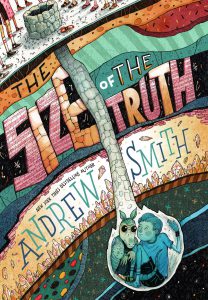 Andrew Smith is best known for writing young adult novels that range from darkly humorous and apocalyptic, like Grasshopper Jungle and Rabbit & Robot, to angst-filled and realistic, like Winger and Stand-off. In a notable departure, Smith just debuted his first middle grade book, the mostly realistic but tiny bit surreal The Size of the Truth. It’s a prequel of sorts, filling in the backstory of Sam Abernathy, Ryan Dean’s precocious, cooking-show-loving roommate from Stand-off.
Andrew Smith is best known for writing young adult novels that range from darkly humorous and apocalyptic, like Grasshopper Jungle and Rabbit & Robot, to angst-filled and realistic, like Winger and Stand-off. In a notable departure, Smith just debuted his first middle grade book, the mostly realistic but tiny bit surreal The Size of the Truth. It’s a prequel of sorts, filling in the backstory of Sam Abernathy, Ryan Dean’s precocious, cooking-show-loving roommate from Stand-off.
Sam narrates The Size of the Truth, jumping back and forth in time between the defining experience of his young life, which occurred when he was four and got trapped at the bottom of a well for three days, and his present, as an eleven-year-old eighth grader dealing with baggage left over from that event. The baggage includes severe claustrophobia and an inability to escape his identity, in Blue Creek, Texas, as “The Little Boy in the Well.” It also infects Sam’s relationship with his parents, who plot out every aspect of his life in an obsessive effort to “[make] sure [he’d] never have the freedom to fall into unseen holes in [his] future” (71). (Their version of his life involves Science Club, AP Physics, Blue Creek Magnet High School, and MIT, as opposed to the culinary school Sam aspires to attend.) Sam, for his part, goes along with this micromanagement because he doesn’t want to “do something as foolish as fall into a hole and disappoint [his] parents ever again” (71).
Sam’s challenge, in the course of this story, is to internalize the truth imparted to him by a probably-not-real talking armadillo named Bartleby (this is the surreal element referenced above), who he remembers visiting him during his time in the well: “don’t go living your life only trying to avoid holes” (172). Sam also needs to learn that other people aren’t always who he’s believed them to be either—most notably, James Jenkins, the older “murderous” boy Sam has always blamed for the well incident. (Everyone in Blue Creek assumes James is destined for football stardom when, unbeknownst to them, he has a whole other identity in Austin, Texas, where his mother lives.)
I don’t know how middle school me would have responded to Smith’s latest book, but it definitely strikes a chord with adult me. In particular, as the mother of a 17-year-old who I want to not only protect but also see flourish and succeed, it’s a good reminder of the damage we do when we project our expectations on to others, filling in their blanks without really listening to their truth.
Smith, Andrew. The Size of the Truth. New York: Simon & Schuster Books for Young Readers, 2019.
Friday Reads – Palaces for the People by Eric Klinenberg
 It is unusual for libraries to be the subject of best-selling books and nationally distributed films. Though, in recent times, that has happened with the publishing of Susan Orlean’s The Library Book, Eric Klinenberg’s Palaces for the People, Emilio Estevez’s film, The Public, and Frederick Wiseman’s epic film documentary, Ex Libris.
It is unusual for libraries to be the subject of best-selling books and nationally distributed films. Though, in recent times, that has happened with the publishing of Susan Orlean’s The Library Book, Eric Klinenberg’s Palaces for the People, Emilio Estevez’s film, The Public, and Frederick Wiseman’s epic film documentary, Ex Libris.
In Palaces for the People, libraries are a subject not the subject. The book title comes from Andrew Carnegie’s philanthropic initiative to support the building of libraries as palaces of the people. Klinenberg contends that public libraries are essential to social infrastructure – defined as the “physical places and organizations that shape the way people interact.” Klinenberg, a sociologist, reflects on how common spaces, like libraries, can aid in repairing our degraded and fractured civic life. He points to a number of “palaces” vital to restoring the common good – parks, diners, farmer’s markets, churches, and more. As for libraries, Klinenberg writes that “Libraries are the kinds of places where ordinary people with different backgrounds, passions, and interests can take part in a living democratic culture.”
Klinenberg rightly recognizes that libraries are community places that have value for all – public programs, space for children and teens, reading spaces, broad-based reading materials, public computers, makerspaces, and much more. Some places are not for everyone, libraries are for everyone. Klinenberg says libraries are “the best case of a physical place that is open and accessible to everyone, regardless of age, ethnicity or race, social class, or even citizenship status. They’re places that are defined by generosity of spirit.”
Libraries are not what they could be. Budget reductions over time have taken their toll. Library funding at national, state, and local levels has declined or remained stagnant. Library staffing, public service hours, and collections have declined. A more positive thought is that libraries, resourceful as they are, have sought ways to increase and improve programming, explore new services, and demonstrate imagination in doing more with less. Klinenberg makes the case for social infrastructure investments. His contention is that financial support – investment – brings people together and builds stronger communities, just as important as public and private investment in the physical infrastructure of roads, bridges, and other components. Imagine what would be possible if times could change to add more funding to library budgets.
Eric Klinenberg is a professor of sociology and director of the Institute for Public Knowledge at New York University. He is the coauthor of the #1 New York Times bestseller Modern Romance and the author of the acclaimed books Going Solo and Heat Wave. He has contributed to The New Yorker, The New York Times Magazine, and This American Life.
Eric Klinenberg. Palaces for the People: How Social Infrastructure Can Help Fight Inequality, Polarization, and the Decline of Civic Life. Crown), 2018.
Friday Reads: Stoner
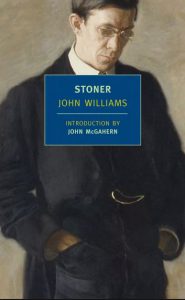 This book is a bit of false advertising, as it is nothing like the title suggests. Nevertheless, I did stick with it, after learning that Stoner actually is a reference to William Stoner, the main character in the novel by John Williams (1922-1994). The book was originally published in 1965. Stoner tells the story of William, born and raised on a small farm in Missouri, who eventually goes off to Columbia, MO to college. The original plan is for Stoner to complete a degree in agriculture, and then return to implement his knowledge for the benefit of the family farm. However, while in Columbia, Stoner develops an interest in literature, eventually earning his Ph.D. and subsequently teaching at the University in Columbia. While Stoner tells the semi-interesting story of his lackluster marriage, his relationship with his daughter, and life teaching English (including faculty relationships and conflicts), it is really more about his stoicism.
This book is a bit of false advertising, as it is nothing like the title suggests. Nevertheless, I did stick with it, after learning that Stoner actually is a reference to William Stoner, the main character in the novel by John Williams (1922-1994). The book was originally published in 1965. Stoner tells the story of William, born and raised on a small farm in Missouri, who eventually goes off to Columbia, MO to college. The original plan is for Stoner to complete a degree in agriculture, and then return to implement his knowledge for the benefit of the family farm. However, while in Columbia, Stoner develops an interest in literature, eventually earning his Ph.D. and subsequently teaching at the University in Columbia. While Stoner tells the semi-interesting story of his lackluster marriage, his relationship with his daughter, and life teaching English (including faculty relationships and conflicts), it is really more about his stoicism.
After reading more about stoicism, it sounds great in theory, but after reading Stoner I’m not buying what the stoics are selling. For some filler material, I also read a bit of the well-known stoic and Roman emperor Marcus Aurelius (121 – 180 AD), whose book Meditations is a mix of hell yes (“The more we value things outside our control, the less control we have”) and fortune cookie philosophy (“The best revenge is not to be like your enemy”). I dunno, sometimes it seems as though revenge along the style of Ray Donovan or Donnie Yen seems appropriate. Depends on the circumstances I suppose. OK – back to the stoics. Generally speaking, the stoic endures hardship or pain without feelings or complaint, and this is exactly the life of Stoner, sans a few very brief moments of joy and happiness. However, after reading Stoner I realized something I had not thought of before or maybe did not see. And that is that the stoic life seems to not only suffer through hardships without complaint (dispassionate), but to also be void of any passion. Let’s face it — sometimes I like to be passionate about the fact that I’m dispassionate about certain things. And that I think is where Stoner falls short, at least on a philosophical level. On a literary level, it’s an OK read, but man you really come away thinking that Stoner is a real sad sack.
Williams, John. Stoner. NYRB Classics, 2006.
Friday Reads: Convenience Store Woman by Sayaka Murata
 Keiko Furukura realized as a child that she was different from everyone else. Her classmates and teachers were increasingly dismayed by her behavior and her family desperately wanted her to be “cured” and become “normal.” Until Keiko found her job at the Smile Mart convenience store during university, she felt doomed to be the odd one out.
Keiko Furukura realized as a child that she was different from everyone else. Her classmates and teachers were increasingly dismayed by her behavior and her family desperately wanted her to be “cured” and become “normal.” Until Keiko found her job at the Smile Mart convenience store during university, she felt doomed to be the odd one out.
But at Smile Mart, the world makes perfect sense. She can follow the employee behavior manual, mimic the speech and dress of her co-workers, and everyone seems happy with her. Flash-forward 18 years; working part-time at a convenience store is no longer enough to keep her friends and family satisfied, and Keiko finds that it is time for a change.
This story gives some insight into the importance of conformity in Japanese culture; it is more important to Keiko’s friends and family that she meet societal expectations, to get married or find a real career path, than to live a content life as a misfit…even if that marriage is dysfunctional or the career makes her unhappy. Keiko must decide if she will do as others think she should… or be true to herself. A short read, this humorous yet heart-breaking tale may have you wondering who the misfits really are.
Murata, Sayaka. Convenience Store Woman. Translated by Ginny Tapley Takemori, Grove Press, 2018.
Friday Reads: ‘Tales from the Perilous Realm’ by J.R.R. Tolkien
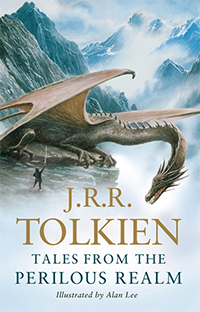 J.R.R. Tolkien is best known as the creator of Middle-earth, the setting of The Lord of the Rings and The Hobbit. But, did you know that he wrote other stories that don’t take place in Middle-earth?
J.R.R. Tolkien is best known as the creator of Middle-earth, the setting of The Lord of the Rings and The Hobbit. But, did you know that he wrote other stories that don’t take place in Middle-earth?
In addition to being a fantasy author, Tolkien was an academic. He wrote modern translations of Sir Gawain & The Green Knight and Beowulf as well as the narrative poems The Legend of Sigurd and Gudrún, based on Norse mythology, and The Fall of Arthur, inspired by the legend of King Arthur.
Those longer works can be a bit hard to get through. Personally, I prefer his shorter original fairie tale novellas. Some of them are collected in Tales from the Perilous Realm:
Roverandom is the story of a dog who is turned into a toy by an angry wizard and recounts his adventures as he searches for a way to undo the spell.
Farmer Giles of Ham is an accidental hero, who must deal with a dragon who has invaded his village.
Smith of Wootton Major is the tale of a blacksmith who, after eating a magical cake, is able to enter the Land of Faery.
Leaf by Niggle is a short story about a painter struggling to finish his greatest work.
The Adventures of Tom Bombadil is the only selection in this book related to Middle-earth. It is a collection of poems written by Hobbits, such as Bilbo Baggins and Sam Gamgee.
I have discovered that Tolkien is a fun and creative storyteller, in all forms. If you’ve only read his books based in Middle-earth, I highly recommend checking out his other stories.
Friday Reads: The Remarkable Journey of Coyote Sunrise by Dan Gemeinhart
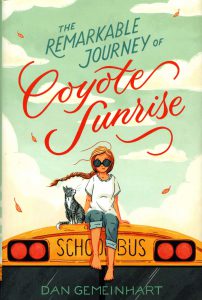 Coyote (12) travels with Rodeo (her father, but don’t call him that) in a refitted old school bus. They go where any whim takes them and only think of the future. One day when Coyote talks to her grandma, she learns the park in their old neighborhood is going to be leveled to become housing. Now Coyote must get home, somewhere Rodeo will not go, so she will trick him into it. She must retrieve the memory box she, her sisters and her mom buried in the park five years ago. They are in Florida and need to get to Washington state in four days, without Rodeo realizing where they are going.
Coyote (12) travels with Rodeo (her father, but don’t call him that) in a refitted old school bus. They go where any whim takes them and only think of the future. One day when Coyote talks to her grandma, she learns the park in their old neighborhood is going to be leveled to become housing. Now Coyote must get home, somewhere Rodeo will not go, so she will trick him into it. She must retrieve the memory box she, her sisters and her mom buried in the park five years ago. They are in Florida and need to get to Washington state in four days, without Rodeo realizing where they are going.
Along the way they give some other travelers a lift and an interesting fellowship develops. First, she finds a kitten who is unusually quiet and seemingly knowing about what humans need, a bit like Coyote herself. She invites Lester to ride with them to Montana to reunite with his former girl. Salvador and his mom help Coyote out of a tough spot right when their car dies, so they join the group. A couple of others join for a spell, including a considerate goat named Gladys. Heartfelt and full of fun too, this book is able to move from silly to touching and bring a tear to your eye. It is aimed at upper elementary to early middle school readers, or for anyone who enjoys a good road trip book about family.
Other books by the author include Good Dog, Scar Island and The Honest Truth.
Gemeinhart, Dan. The Remarkable Journey of Coyote Sunrise. Henry Holt and Co., 2019.
Friday Reads: The Sound of a Wild Snail Eating by Elisabeth Tova Bailey
“I found a snail in the woods. I brought it back and it’s right here beneath the violets …”
“Is it alive?”
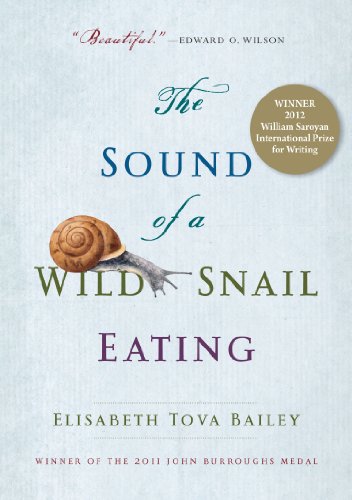
This is the first question Bailey asks of the snail in her book, The Sound of a Wild Snail Eating, in which she recounts her survival through a debilitating relapse of her chronic illness. Once a traveler and gardener, she is rendered bedbound and alone, save for the occasional visits of loved ones and her caregiver. And then she is gifted the company of a wild woodland snail, brought from its habitat with a friend’s potted offering of wild violets.
As it so happens, the snail is alive, and its motion and unique liveliness breathes purpose into Bailey’s stalled life.
The Sound of a Wild Snail Eating is a small book. Its pages number at 170; 191 if you count the acknowledgements and bibliography. It’s a quick read that gets technical at times but never becomes wholly inaccessible. Its style, complete with pages dotted here and there with monochrome drawings of snails, is a tribute to the 19th century naturalists of whom Bailey seems fond, and she follows in their footsteps – or, rather, to borrow her imagery, she glides along the slime trail they left behind.
Bailey draws from scientific literature and poetry in rhythm with her observations, making the book one-part informative essay and one-part ode. Peppered in between discussions of the snail’s locomotion, diet, and evolution are the chronicles of her illness, told in an almost tangential fashion, secondary but parallel to the snail’s life, where she both wishes to be more like the snail and longs to feel human again. Is it alive, she asks of the snail and its stillness during their first introduction. Am I alive, she seems to ask; or, the darker question that lingers, one with an answer she couldn’t know, will I survive this?
The Sound of a Wild Snail Eating is best enjoyed in the perfect stillness that might allow oneself to overhear a snail at its dinner. Bailey asks the reader to slow down and ponder – and wonder – at nature and its small, unnoticed creatures and their tiny, significant lives. The reward for your patience is a quiet sort of jubilation and a feeling of hopeful resilience.
Bailey invites us to consider the snail and, in doing so, asks if we might also see ourselves.
Bailey, Elisabeth Tova. The Sound of a Wild Snail Eating. Algonquin Books of Chapel Hill, 2010.
Friday Reads: Inheritance by Dani Shapiro
 What do our parents really leave us? Is it money, or a house? Seeing my father’s eye’s when I look in the mirror or my mother’s nose? Is it memories, the good and the bad? What if you found your dad wasn’t your biological father? That all the family history, the aunts and uncles, the cousins and grandparents, that they didn’t really belong to you. At least not in the way you thought. This is the basis for Dani Shapiro’s poignant and timely memoir, “Inheritance: A Memoir of Genealogy, Paternity, and Love.” This is not just the tale of the author’s search for her biological father, but her desire to know the secrets her parents kept.
What do our parents really leave us? Is it money, or a house? Seeing my father’s eye’s when I look in the mirror or my mother’s nose? Is it memories, the good and the bad? What if you found your dad wasn’t your biological father? That all the family history, the aunts and uncles, the cousins and grandparents, that they didn’t really belong to you. At least not in the way you thought. This is the basis for Dani Shapiro’s poignant and timely memoir, “Inheritance: A Memoir of Genealogy, Paternity, and Love.” This is not just the tale of the author’s search for her biological father, but her desire to know the secrets her parents kept.
I listened to the audiobook, published by Random House, and narrated by the author herself. Listening to the author tell her own story, hearing her voice and emotion as she recounts the journey she takes after this discovery made the experience even more enjoyable. I choose this book in my attempt to read more non-fiction this year, and it didn’t disappoint.
Shapiro, D. (2019). Inheritance: A Memoir of Genealogy, Paternity, and Love.
Posted in Books & Reading, General
Tagged #FridayReads, Book Review, Dani Shapiro, Friday Reads, Inheritance, Memoir
Leave a comment
Friday Reads: The Library Book by Susan Orlean

The Library Book by Susan Orlean is a necessary and fascinating read for anyone who has used a library—even more so for anyone who works in a library. Orlean tells the story of the Los Angeles Central Library, its founding and its operation, and about a dramatic 1986 fire and the following investigation. Of special interest to Nebraskans, the building itself was designed by Bertram Goodhue, who was also the architect for another building you might be more familiar with: the Nebraska State Capitol building.
The way Orlean tells the story is as interesting as the investigation itself. The book is true crime, history, biography, and homage. She describes her own emotional connection to visiting her hometown library with her mother as a child, and then returning to libraries much later, after having a child of her own, and she begins to appreciate what an incredible societal wonder the modern library is.
Orlean also tells the stories of pioneers, free thinkers, and risk takers who made the Los Angeles Central Library possible, like Mary Foy, who became the head librarian of the Los Angeles Central Library in 1880, when men still dominated the field—and when she was only eighteen years old. With thoughtfulness and sensitivity, she talks about the emotional aftermath of the 1986 fire, for the workers and patrons of the Central Library, with personalized detail. She addresses the realities of the twenty-first century public library with respect and without sentimentality.
I dragged my feet finishing this book, because I didn’t want it to end. I knew from the formatting of the first page—I won’t give away how each chapter is introduced—that I was reading a book about libraries by someone who knew them and loved them.
If you’re old enough to remember 1986, but you don’t remember the Los Angeles Central Library fire, it might be because another catastrophic event happened a few days before in Chernobyl, which overshadowed the fire in the news. After you read the book, you might want to watch news clips and video of the time—and view other reactions to the book. The story told by the book has encouraged a reckoning and remembering by those affected, and it is powerful.
I took my copy of the book on a field trip to another library designed by Goodhue—in the aforementioned Nebraska State Capitol building. Pretty library photos will be on social media soon, and I will add a link here when that happens.
Orlean, S. (2018). The library book.
Friday Reads: All Systems Red (The Murderbot Diaries #1) by Martha Wells
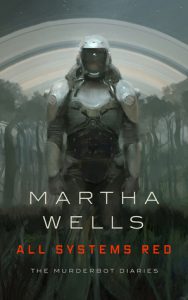 “As a heartless killing machine, I was a terrible failure.”
“As a heartless killing machine, I was a terrible failure.”
Murderbot (as they call themself) is a part organic/part machine SecUnit (security unit) who is contracted out by The Company to various research and exploration teams traveling to other planets to keep them safe, and to keep an eye on what they’re doing. Unlike other SecUnits, however, this particular one has hacked their own (cheaply made) governor module so they no longer have to follow the Company’s strict protocols. Rather than turning against all humans or anything overly violent, Murderbot just wants to be left alone to watch thousands of hours of sci-fi/adventure soap operas and to do the bare minimum of work (just enough so no one realizes they now have free will).
The current job includes a group of humans who are exploring a planet for scientific reasons that don’t matter much to Murderbot. This is a fairly easy job until equipment starts to fail, creatures start attacking, and vital pieces of information seem to be missing which puts the humans all in danger. Now they must find out who is behind the conspiracy and what’s going on, keep the humans safe from other (more heartless) robots, and get them all off of the planet while desperately trying to avoid more social interaction than is necessary.
All Systems Red is the first novella of four in The Murderbot Diaries which all follow our snarky SecUnit. Quick reads with fast-paced stories, engaging characters, lots of snarky humor, cyborg/robot/human battles, and tentative friendships.
- All Systems Red
- Artificial Condition
- Rogue Protocol
- Exit Strategy

